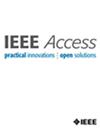Bandwidth Extension of Resistive-Feedback CMOS Inverter Amplifier Using T-Coil Peaking
IF 3.6
3区 计算机科学
Q2 COMPUTER SCIENCE, INFORMATION SYSTEMS
引用次数: 0
Abstract
This paper presents a broadband CMOS three-stage resistive-feedback inverter (RFI) amplifier for high-speed applications. A novel T-coil-based peaking technique is proposed, combining over-shunt and gate peaking to extend the bandwidth with reduced inductance. Theoretical analysis derives design equations and shows that the proposed structure achieves a bandwidth extension ratio of 2.3, matching conventional gate peaking performance with only one-third the inductance, thereby enabling chip area reduction. Fabricated in a 28 nm fully depleted silicon-on-insulator CMOS process, the amplifier occupies an active area of only 0.0094 mm2. Small-signal measurements show a gain of 16.2 dB, a 3-dB bandwidth of 31.5 GHz (gain-bandwidth product (GBW) =203.38 GHz), and low power consumption of 5.6 mW. The measured eye diagram confirms reliable performance, with an output amplitude of 333.4 mVpp, signal-to-noise ratio of 8.9, rise time of 15.0 ps, and fall time of 15.3 ps, meeting the 28 Gbps non-return-to-zero signaling requirements. Compared to previous broadband CMOS amplifiers, the proposed T-coil peaking RFI amplifier demonstrates superior GBW performance in terms of active area and power consumption.利用t圈调峰技术扩展电阻式反馈CMOS逆变放大器的带宽
本文提出了一种适用于高速应用的宽带CMOS三级电阻反馈逆变器(RFI)放大器。提出了一种新的基于t型线圈的调峰技术,将过分流和栅极调峰相结合,在减小电感的同时延长带宽。理论分析推导出设计方程,表明该结构的带宽扩展比为2.3,在电感仅为1 / 3的情况下达到传统栅极峰值性能,从而减小芯片面积。该放大器采用28 nm完全耗尽绝缘体上硅的CMOS工艺制造,其有效面积仅为0.0094 mm2。小信号测量显示增益为16.2 dB, 3db带宽为31.5 GHz(增益带宽积(GBW) =203.38 GHz),低功耗为5.6 mW。实测眼图性能可靠,输出幅值333.4 mVpp,信噪比8.9,上升时间15.0 ps,下降时间15.3 ps,满足28gbps不归零信号要求。与以前的宽带CMOS放大器相比,所提出的t线圈峰值RFI放大器在有源面积和功耗方面表现出优越的GBW性能。
本文章由计算机程序翻译,如有差异,请以英文原文为准。
求助全文
约1分钟内获得全文
求助全文
来源期刊

IEEE Access
COMPUTER SCIENCE, INFORMATION SYSTEMSENGIN-ENGINEERING, ELECTRICAL & ELECTRONIC
CiteScore
9.80
自引率
7.70%
发文量
6673
审稿时长
6 weeks
期刊介绍:
IEEE Access® is a multidisciplinary, open access (OA), applications-oriented, all-electronic archival journal that continuously presents the results of original research or development across all of IEEE''s fields of interest.
IEEE Access will publish articles that are of high interest to readers, original, technically correct, and clearly presented. Supported by author publication charges (APC), its hallmarks are a rapid peer review and publication process with open access to all readers. Unlike IEEE''s traditional Transactions or Journals, reviews are "binary", in that reviewers will either Accept or Reject an article in the form it is submitted in order to achieve rapid turnaround. Especially encouraged are submissions on:
Multidisciplinary topics, or applications-oriented articles and negative results that do not fit within the scope of IEEE''s traditional journals.
Practical articles discussing new experiments or measurement techniques, interesting solutions to engineering.
Development of new or improved fabrication or manufacturing techniques.
Reviews or survey articles of new or evolving fields oriented to assist others in understanding the new area.
 求助内容:
求助内容: 应助结果提醒方式:
应助结果提醒方式:


